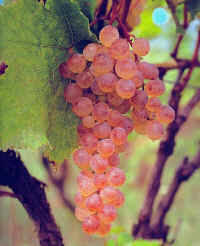Rkatsiteli
Rkatsiteli means “ red stem” in Georgian (Pronounced "rkah-tsee-tely"; Georgian რქაწითელი)
While historical documentation suggests that it
has been cultivated in Kakheti (East Georgia) since the first century
AD, it is thought to be linked to populations who
lived along the Alazani river. This grape, whose skin
is rich in tannins, is the variety that’s most often
used when producing wine in kvevri (amphora). It is characterized with abundant harvest (average
weight of a bunch is about 160-250 gr.). Average harvest is 9-10 tons per hectare. Sugar content of the ripe grape reaches 240 gr/dm3, with the acidity of 7-8 gr/dm3.

Organoleptic characteristics of Rkatsiteli European style dry white wine:
Color: its vivid and luminous with a tendency toward bright gold.
Aroma: its intense, round flavor has a noteworthy
compactness that expresses hints of sweetness which
range from floral flavors to the taste of dried fruit.
Taste: tasty and wide-ranging, it is characterized by
the deeply elegant touch of citrus, lemon, and bitter almond, expressing
a slightly mineral, almost saline flavor.
Though its acidity is perceivable, it is by no means
over-powering. This tasty wine effectively mirrors
its territory, giving wine-lovers a feel for the
atmosphere in which it was created.
Food suggestions: This wine accompanies delicate
dishes such as vegetable-based first courses.
Try it with white meats or with squid and flying
squid on a skewer.
Serving temperature: 10-12°C
Alcohol content % vol: 12-13
Organoleptic characteristics of Rkatsiteli Georgian style orange or amber dry wine:
"To say these wines aren't to every taste is an understatement. Begin with the look - hues that charitably draw comparisons to fall foliage and less charitably to week-old apple juice. Flavors are less fresh fruit than dried, verging from orange to reddish - nectarines, apricots, quince - plus deep honey and nutty accents.
If most whites have either high-acid freshness or rich flavors from sitting in barrels and on their lees (spent yeast cells), orange wines have something different: tannin. They grip the tongue not unlike a red wine, and so some tasters find the taste bitter or austere. For that matter, they typically need to be decanted and served around room temperature, like red wines.
But for the occasional convert, they reveal their potential. You wind up with a strange hybrid; the flavors of white grapes, the texture of red. The weirdness is the key to their versatility.
For winemakers, they have become a symbol of returning to more natural methods - really a shot against the modern industry's pristine and science-based approach".
.